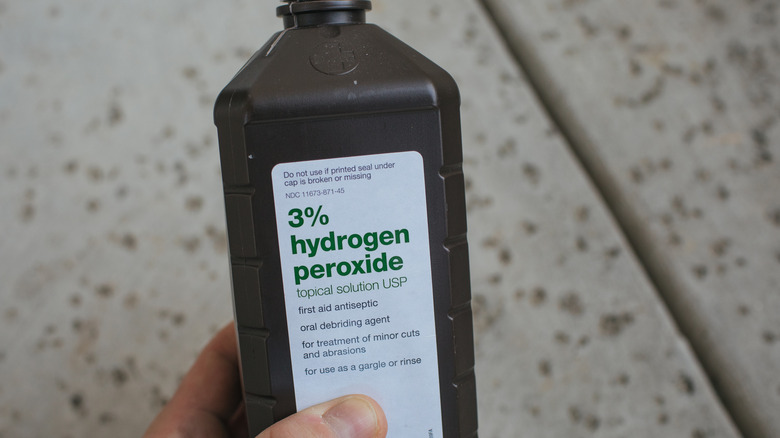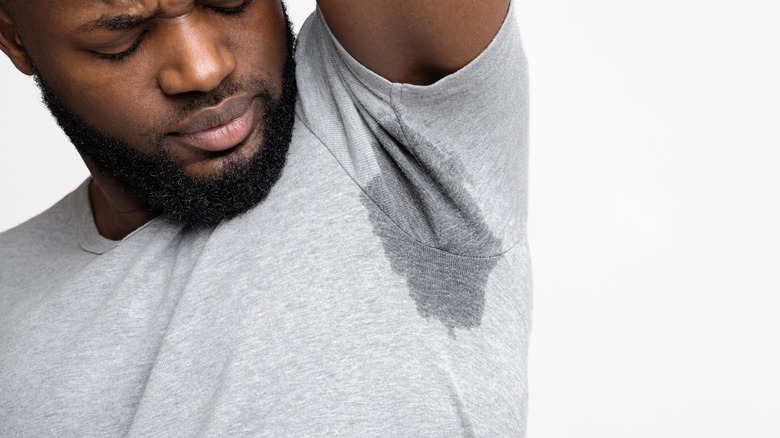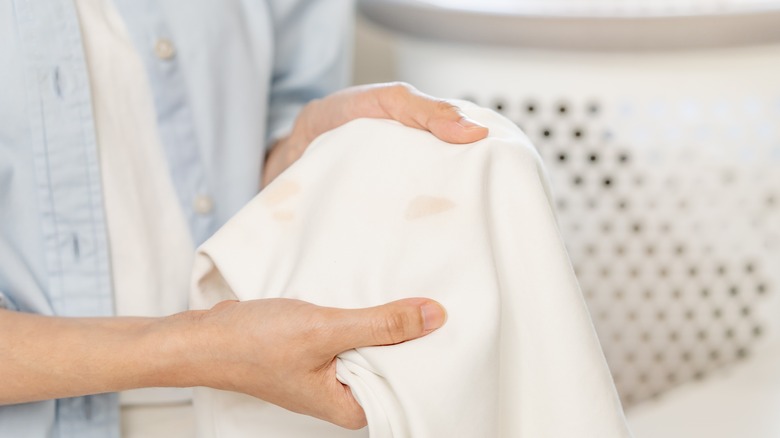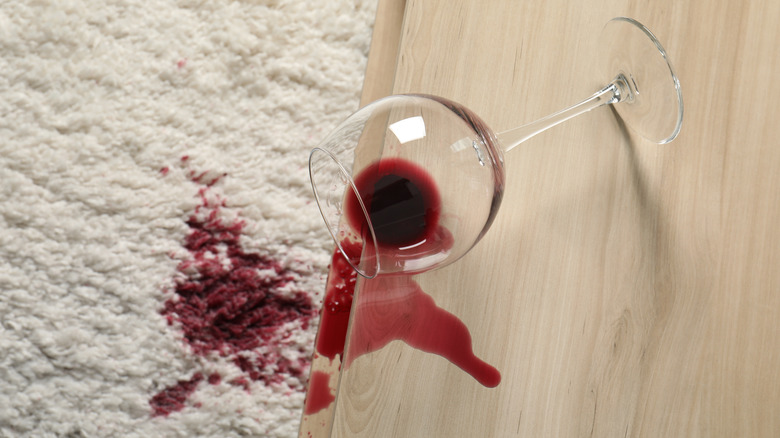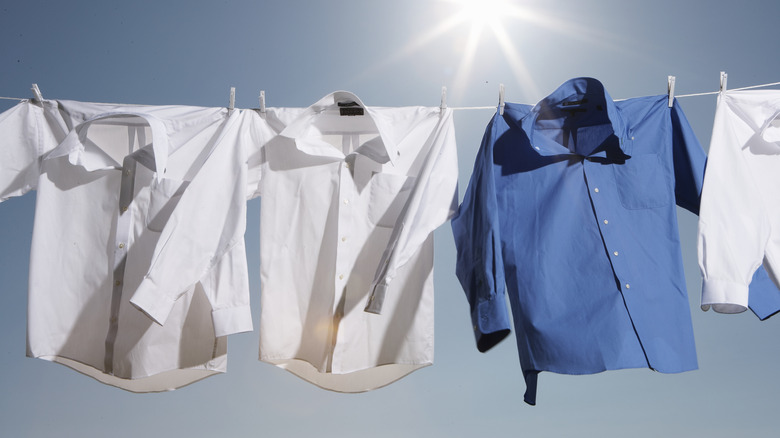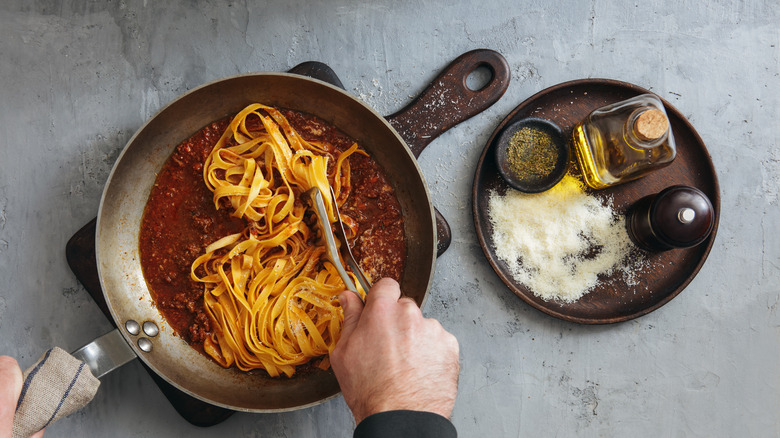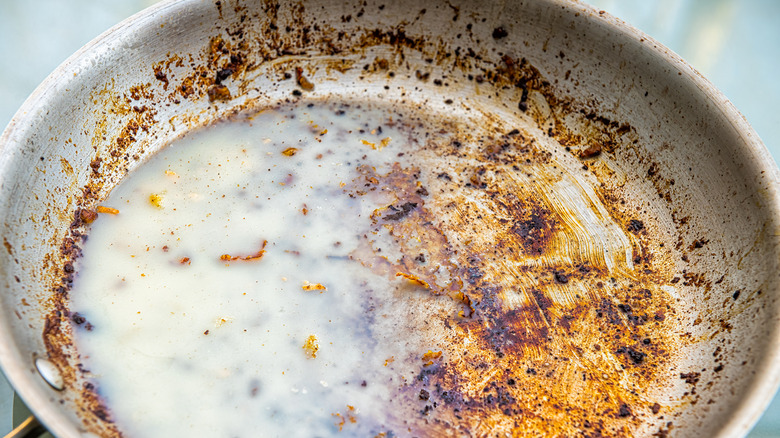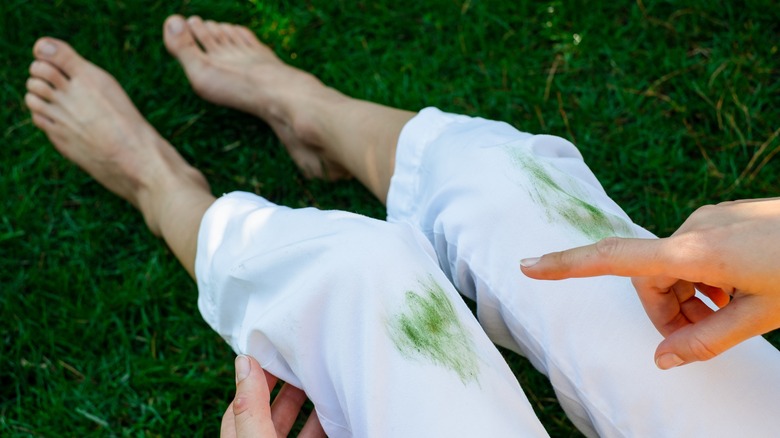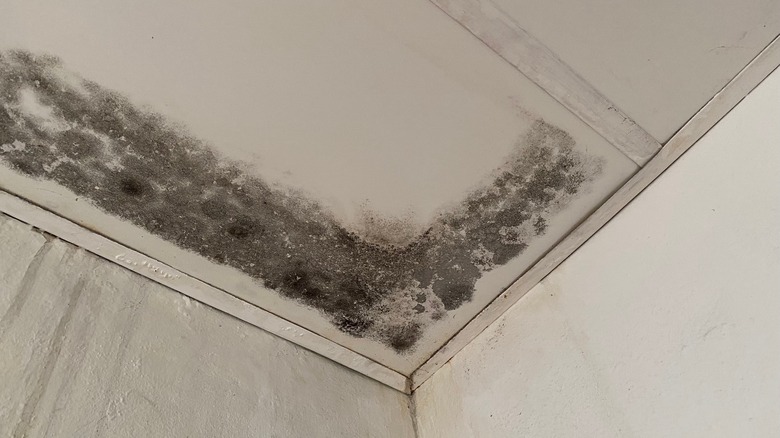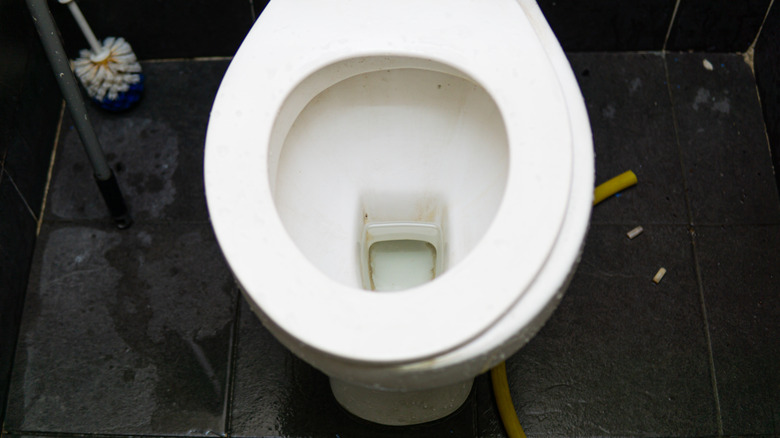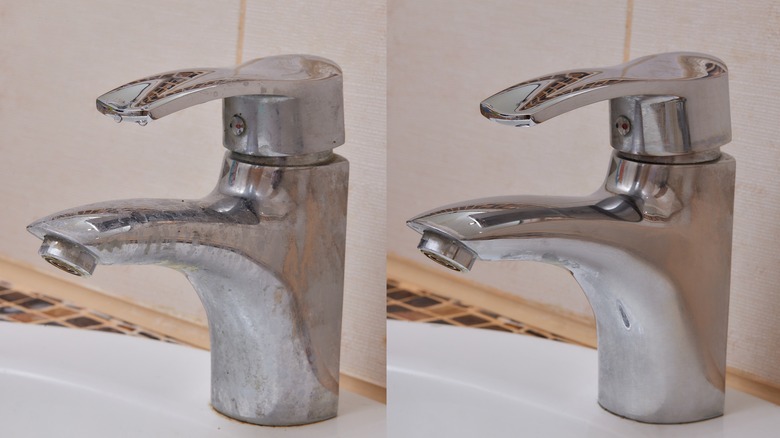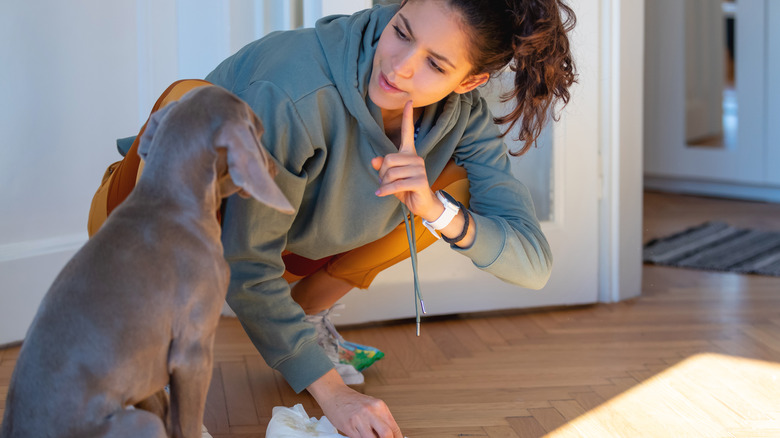All The Stubborn Household Stains You Can Get Rid Of With Hydrogen Peroxide
Hydrogen peroxide (H2O2) is a compound of hydrogen and oxygen that is both natural and powerful when it comes to cleaning and disinfecting a wide array of materials. Due to its oxidizing action, it effectively removes difficult stains from many porous and non-porous surfaces as well as a variety of textiles and carpet fibers. The 3-percent hydrogen peroxide solution that is commonly packaged in brown plastic bottles and sold in pharmacies and grocery stores is a boon to your arsenal of house-cleaning products.
If you're looking for a safe and sustainable cleaner that won't harm the environment, hydrogen peroxide is a reliable product. Due to its molecular makeup, it decomposes into oxygen and water, leaving behind no toxic residue or byproducts. When it comes to removing ugly stains from surfaces around your home, hydrogen peroxide breaks them down on a molecular level. It's effective on porous surfaces like carpets, wood, and clothing fabrics. But it's equally potent in removing stains from hard surfaces like metal cookware, sinks, and toilet bowls.
Sweat stains on clothing, bed linens, and mattresses
Although sweat is mostly water, it also contains proteins, oils, and salt. These ingredients leave behind unsightly stains as the sweat evaporates from your clothing, sheets, pillow cases, and mattresses. To remove these stains, reach for hydrogen peroxide. When your clothing shows sweat stains, it's time to do a pre-soak prior to laundering. Mix equal parts of cold water and hydrogen peroxide to soak the garment for 30-to-45 minutes. Check to see if the stains have been eradicated. If not, repeat the procedure before cold-water washing in the washing machine.
For sweat-stained sheets, you can mix a pre-wash treatment using two parts hydrogen peroxide to one part liquid dish soap. Rub the mixture into the stain and let it sit for 30-to-45 minutes before laundering in cold water. Then, hang the bed linens to air dry. If your mattress is stained from sweat, you'll need to create a mixture of 3 tablespoons of baking soda with ½-cup of hydrogen peroxide plus 1 teaspoon of liquid dish detergent. Apply this DIY solution to the sweat stains on your mattress and rub it in with a clean cloth. Let the mixture sit for 5-to-10 minutes, then wipe away the excess.
Be aware that hydrogen peroxide is a mild bleach. It can remove the color from some fabrics. Test it on the fabric in an unseen place to determine if it bleaches the color before you apply it more liberally.
Dull, dingy, and stained laundry that should be bright white
It's such a satisfying feeling when your white socks, shirts, sheets, and towels come out of the washing machine sparkling clean and brilliantly white. But sometimes, they start to look drab and discolored, even after you've laundered them. In fact, the stains may be old and their origins may be unknown. Hydrogen peroxide is a safe and natural oxygen bleach that brightens white fabrics in the washer. It's milder than chlorine bleach and less damaging to fabrics. Add 8 fluid ounces (1 cup) of 3-percent hydrogen peroxide to a washing machine load of whites.
If you want to treat a specific, stained area on a piece of white laundry, you can pour a small amount of hydrogen peroxide straight from the bottle onto the stain. Let it soak into the fabric and sit for no more than 10 minutes before washing the item with the rest of your laundry. If the hydrogen peroxide sits for too long, it can deteriorate the fabric.
Food, wine, and coffee stains on carpets
Let's face it, spills happen. When bright- and dark-colored liquids spill onto carpets, they can leave highly visible stains that detract from your home's decor. Think tomato sauce, red wine, coffee, and cranberry juice. Hydrogen peroxide is a life saver when it comes to removing stains from carpets. Although it's a mild and generally color-safe form of bleach, it's advisable to test the hydrogen peroxide in a hidden place on your carpet to ensure that it does not remove the color from the floor covering. Once you know it won't bleach the carpet, you can proceed with a 3-percent solution of hydrogen peroxide.
For a red wine stain, apply a mixture of 3 parts hydrogen peroxide with 1 part dishwashing liquid. Dab the solution into the stain and let it sit for 20 to 60 minutes. Then blot the stain with a clean, dry cloth. If tomato sauce spills on your carpet, you can remove the stain with a mixture of 1 tablespoon of hydrogen peroxide and 3 tablespoons of cold water. Pour the mixture onto the stain, cover it with a clean cloth, and let it sit for 30 minutes. Then, rinse with water and blot to dry. For a coffee stain, you can put hydrogen peroxide into a spray bottle and spray it directly onto the spot. Then, place a moistened white cotton dish towel over the stain and run a hot iron over it for 20-30 seconds. Next, rinse the area with a damp sponge and blot it with a dry towel.
Blood stains on clothing and sheets
The life-saving hemoglobin that causes our blood to clot also causes it to bind with the textile fibers in fabrics. This situation creates tough stains that are hard to get out, especially once the blood has dried. Due to its oxidizing action, hydrogen peroxide produces a chemical breakdown of dried blood, allowing it to be lifted from textile materials. For clothing, upholstery, carpets, and other fabrics, you can pour a small amount of 3-percent hydrogen peroxide directly onto a dried blood stain. Let it sit for 5 minutes and blot with a paper towel. Then, rub gently with a microfiber cloth and rinse with cold water.
You can get dried blood stains out of sheets and pillowcases by soaking the stained spots in hydrogen peroxide. Place the sheet in a large bowl or bucket and pour approximately ½-cup of hydrogen peroxide over the stain. Add cold water to submerge the spot. Let it soak for 24 hours, then launder the sheet in the washing machine on a cold-water setting. Follow up by hanging the sheet to air dry, as the heat from a dryer might cause any residual amount of blood stain to set more permanently in the fabric.
Food stains on marble countertops
White and light-color marble countertops lend a high-end vibe to contemporary kitchens. But they're susceptible to staining from dark and brightly colored liquids and foods. When tomato sauce, coffee, wine, and other substances stain the marble, hydrogen peroxide provides a viable cleaning method. One strategy involves making a paste from 1 part hydrogen peroxide and 2 parts baking soda. Apply the paste to the stain and let it sit for a few minutes. Then, scrub with an old toothbrush and rinse with a wet towel. Finally, dry the area with a dry cloth to remove any residue. Alternatively, you can use enough flour to make a paste with a small amount of hydrogen peroxide. Apply the paste to the stain and cover it with plastic wrap. Let it sit for 12 hours or overnight before removing the plastic wrap and washing the paste off the marble.
If you don't want to make a paste, you can cover the marble stain with a paper towel and pour on enough hydrogen peroxide to soak the towel. Let it sit overnight before rinsing the marble. If one application does not fully remove the stain, it may be necessary to repeat this process for an additional 12-hour period.
Food stains on pots and pans
Those pots, pans, and baking sheets that were so bright and shiny when you bought them tend to become discolored over time with blackened, cooked-on stains. You can make them bright again with hydrogen peroxide. First, sprinkle an ample amount of baking soda over the surface of your dry pans. Then, spray on hydrogen peroxide from a spray bottle, soaking the baking soda. Let the cookware sit for 12 hours or overnight. Follow up by scraping off the dried paste with a plastic spatula and washing the cookware with dish detergent and water.
To remove ugly stains from the inside of a pot or frying pan, you can utilize heat from the stove to speed up the cleaning process. Pour ½-inch of hydrogen peroxide into the pan and add ¼-cup of baking soda. Put it on the stove and heat the pan until the liquid begins to bubble. Take the pan off the heat and allow it to cool for at least 10 minutes. Then, scrub the inside of the pan and rinse it with clear water. Dry it with a cloth, and buff it for a renewed shine.
Grass stains on clothing and sneakers
Who doesn't like to sit or lie in lush, green grass on a sunny day in the spring? Children are especially known to take advantage of thick lawns for playing and relaxing all summer long. But, the results of these pleasant activities may include the grass stains that show up on garments, socks, and shoes.
Whether you're eradicating grass stains from clothing or sneakers, the process is the same. First, make a paste from hydrogen peroxide and baking soda. For a small stain, you'll need only 1 tablespoon of baking soda and a few drops of hydrogen peroxide. Increase the amount for larger stains. Next, use an old toothbrush to apply the paste, covering the stain completely. Let it sit for 30 minutes. Then, use the brush to scrub the stain and let it sit for an additional 10 minutes. Finally, finish the job by rinsing the item thoroughly with cold water.
The process is a bit messy due to the way that baking soda dries to a caked-on powder. If you prefer, you can substitute dishwashing liquid for the baking soda. Mix a squirt of dish soap with each tablespoon of hydrogen peroxide and follow the steps described above.
Mold and mildew stains on walls and ceilings
Mold and mildew are living fungi that thrive in moist environments and cause serious problems in your home. You can use hydrogen peroxide to safely kill mold and mildew and remove their stains. It's a cleaning agent that is preferred over bleach. Hydrogen peroxide is environmentally friendly, and it does not produce fumes or leave behind a toxic residue on surfaces.
To kill mold and mildew growing on walls, ceilings, floors, and fixtures in bathrooms and kitchens, you'll need to pour 3-percent hydrogen peroxide into a spray bottle. There's no need to dilute the liquid. Spray the full-strength liquid onto the mold to fully saturate the stains. Let it sit for 10 minutes or until the hydrogen peroxide stops bubbling. Then, scrub the area with a microfiber cloth to remove all mold spores and eradicate the dark stains. Finish up by wiping away any residue with a clean cloth or towel.
Toilet bowl stains
Although you clean your toilet on a regular basis, some toilet bowl stains simply do not respond to typical cleaners. These persistent stains may be caused by minerals in hard water, limescale, mold, rust, and copper from corroded pipes. To get the toilet bowl truly clean, you can rely on occasional treatments with hydrogen peroxide.
Powdered hydrogen peroxide works best for cleaning toilets, as the granules produce friction when you scrub the bowl with a brush. Pour ½ cup of the powdered cleaner into the toilet and let it sit for 20 minutes. Then, scrub with your toilet brush and flush. For persistent stains, simply repeat the process.
If you don't have powdered hydrogen peroxide on hand, you can use the 3-percent liquid form. Pour ½-cup of the liquid into the toilet bowl and let it sit for 20 minutes. Then, sprinkle a bit of baking soda into the bowl and scrub with a brush before flushing.
Hard water stains
The water that flows from the faucets in your home comes out of the ground where it passes through layers of rock. Along the way, it may acquire trace amounts of dissolved minerals such as calcium, iron, potassium, magnesium, and more. A significant mineral content results in hard water. When it evaporates from household surfaces, hard water leaves behind stains from the minerals. If you have this type of water in your geographical region, you know that the mineral stains pose some of the toughest cleaning challenges in your home.
To eliminate hard water stains on sinks, tubs, faucets, toilets, and other hard surfaces, you can pour 3-percent hydrogen peroxide directly onto the stain. As a more convenient alternative, pour the liquid hydrogen peroxide into a spray bottle and spray it on the stain. Let it sit for 10 to 15 minutes and follow up by scrubbing with a brush. Then, thoroughly rinse the area with clear water and dry the surfaces with a soft cloth or towel.
Pee and poop stains from household pets
We love our furry friends and four-legged housemates. But, let's face it, they sometimes miss the mark when it comes to sanitary practices. When you're cleaning up a pet's accident, the goals are to eliminate the odor and remove the stain. Hydrogen peroxide accomplishes both objectives by killing the bacteria and breaking down the molecules that cause the stain.
First, fill a spray bottle with a mixture of 2 cups of hydrogen peroxide and 2 tablespoons of liquid dishwashing detergent. Spray the stain to saturate it, and let it sit for one minute. Then, scrub with a brush and rinse with clear water. Finally, dry the area with a clean cloth, wiping away any residual stain or cleaning solution.
For an alternative cleaning mixture, you can combine 4 tablespoons of hydrogen peroxide with 2 tablespoons of warm water and a few drops of dish detergent. Pour the ingredients into a spray bottle and treat the stain. After scrubbing, rinse the area with clear water and dry with a towel or soft cloth.
